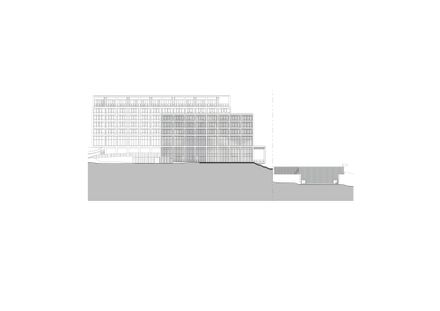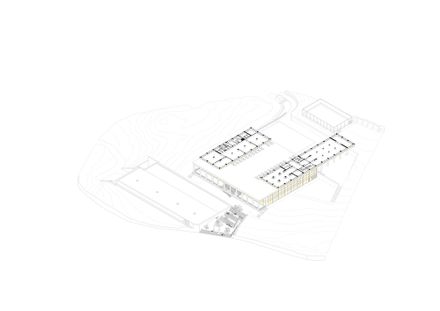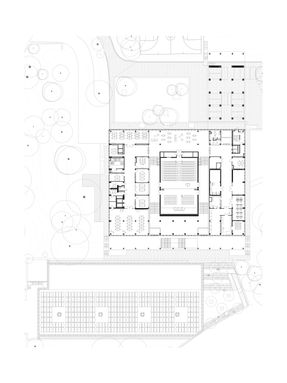
Corvinus Gellert Campus
ARCHITECTS
Plant – Atelier Peter Kis
CLIENT
Maecenas Universitatis Corvini Foundation
MANUFACTURERS
Ceramiche Refin, Gerflor, Knauf, Liko-s, Litracon, Polycon, Slalom, Tarkett, Topakustik, Wicona
LEAD ARCHITECT
Peter Kis
LANDSCAPE ARCHITECTURE
S73 Ltd.
STRUCTURE ENGINEERS
Caec Ltd.
PROJECT ARCHITECT
Gabor Rantal, Aniko Toth, Starkbauer Lilla, Marton Kovumes, Bence Rev, Domonkos Kazmer, Aron Baki
INTERIOR DESIGN
Zsolt Krausz, Rebeka Posta, Vivien Tamas, Boroka Ban, Lilla Balajthy
GENERAL DESIGNER
Lean Tech Ltd. - Ilku Gyorgy
GENERAL CONTRACTOR
Market Epito Ltd.
YEAR
2024
LOCATION
Budapest, Hungary
CATEGORY
University
Budapest Corvinus University, Hungary's oldest institution dedicated to economics, is located on the Pest side of Budapest in beautiful 19th-century buildings.
The university had long aspired to expand with a modern building, but this wasn't feasible within the dense urban fabric of Pest.
Finally, the former State Administration College on the opposite bank of the Danube, within easy walking distance, was selected for redevelopment.
Recycling the existing structure allowed the building to be constructed economically, sustainably, and in a forward-thinking spirit, resulting in one of the country's most advanced university buildings.
The project was preceded by extensive community planning.
Corvinus University aimed to create a space where students feel at home and can engage in a modern educational environment that moves beyond traditional teacher-student roles.
This new vision required collaborative, adaptable spaces, designed to accommodate students' evolving needs, supporting comfortable learning and working environments, both in-person and online.
The building was initially constructed in phases starting in 1973, with the massing reflecting these stages.
Preserving its character—rising toward Gellért Hill and blending into the hillside near the villa district—remained an essential design consideration.
The two towers rising above the two-story horizontal mass represent a distinctive 1970s aesthetic that developers sought to preserve.
PLANT
Atelier Peter Kis won the design rights through a competition, notably by reconfiguring the main entrance, creating a new agora that improved pedestrian access from other university buildings and introduced an entrance befitting the university's prestige.
The entrance plaza provides easy access to the sports hall and an impressive, cantilevered staircase leading to a double-height reception hall.
The cantilevered, columned entrance space gives the impression of floating toward the street.
In this covered space, Attila Csörgő's sculpture, "Five Cubes," greets visitors, symbolizing the university's open-minded approach through a mathematical metaphor involving the deconstruction and reassembly of a simple geometric form.
The reception hall is an open, representative space, retaining the spatial structure of the former building as a valuable feature.
The Auditorium, a central element once and now, is flanked by spacious staircases with skylights that bring natural light into the circulation areas.
The reception desk, made of pixel concrete, a Hungarian innovation (Litracon), has thin glass fibers embedded in high-quality concrete, creating a special lighting effect.
The architects and the university collaborated with Lumoconcept lighting designers to create a lighting installation above the reception area, inspired by the box diagrams commonly used in economics.
Two towers emerge from the large horizontal mass of the building, named "J" for "Jövő", meaning Future and "K" for "Közösség" meaning Community.
The smaller "J" tower houses entirely educational spaces, including collaborative areas, small lecture rooms, focus rooms, and spaces for executive training. The "K" tower contains dormitory rooms across four floors.
The university's dormitory is now arguably Hungary's most scenic dorm, designed based on extensive community input from students, who prioritized comfort.
Each floor features large common areas, and students are housed in 2-3 person units with private bathrooms. Community areas are designed for shared cooking, dining, and movie nights.





















































































